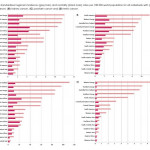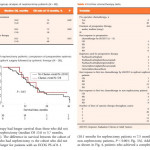Editorial: New Strategies for Treating RMC
In the current issue of BJUI, Shah et al. [1] present a multi-institutional study of 52 patients with renal medullary carcinoma (RMC) collected over a 15-year period. This notoriously lethal and rare form of kidney cancer, associated with sickle cell trait and disease, usually affects young adults. In the study, the median age was 28 years, 94% of the patients presented with stage 3 or 4 disease, and the median overall survival was only 13 months. Nephrectomy, performed in 75% of patients, as opposed to systemic therapy alone, was associated with longer survival (16.4 vs 7.0 months). Of the 45 patients who received platinum- or carboplatinum-based systemic chemotherapy, 13 (29%) had an objective response, while there was no objective response in 28 patients treated with vascular endothelial growth factor-targeted agents, which are highly effective in conventional clear-cell carcinoma of the kidney. Only seven patients survived >2 years, with two long-term survivors at 5 and 9 years after nephrectomy and various combinations of systemic therapy.
Recent reports suggest new insight into this lethal form of kidney cancer, raising hope about the development of effective systemic agents. Calderaro et al. [2] used gene expression profiling, array genomic hybridization, and RNA and whole-exome sequencing to study frozen tissue in five patients with RMC. They reported an interchromosomal balanced translocation that disrupts the SMARCB1 gene, a tumour suppressor on chromosome 22 encoding BAF47 protein, which impairs the SWI/SNF complex regulating chromatin remodelling, which, in turn, leads to increased cyclin D transcription and downstream over-expression of the transcriptional regulator EZH2. EZH2 is the enzymatic subunit of the PRC2 complex and its histone methylation function. EZH2 also has a PRC2-independent role in transcriptional activation and can methylate a number of non-histone proteins. Over-expression of EZH2 can lead to cancer by changing expression of tumour suppressor (pRB) and DNA-damage repair genes. EZH2 over-expression and loss of function mutations are associated with a diverse group of cancers including liver, breast, prostate, endometrial, melanoma, bladder and lymphoma, none of which are as rare as RMC but in which targetable agents can be tested for their ability to disrupt this pathway [3]. Interestingly, SMARCB1 gene truncating and or deletion mutations have been reported in the equally rare and lethal paediatric rhabdoid tumour of the kidney [4] and loss of immunoexpression of SMARCB1 reported in the clinically aggressive collecting duct renal cancer, which is morphologically similar to and often difficult to distinguish from RMC [5].
A number of small-molecule compounds able to target both EZH2 and PRC2 complex are currently undergoing preclinical testing (i.e. DZNEP, E11, EP2005687), phase I trials (GSK126), and phase II trials (EPZ-648, Tazemetostat) [3]. A phase II multicentre study of tazemetostat, a selective small-molecule inhibitor of EZH2, is underway and accruing patients with rare tumours with abnormalities in this pathway, including synovial-cell sarcoma, RMC and rhabdoid tumour of the kidney, for which there are no standard therapies [6]. Contemporary genomic research has great potential to identify such critical oncogenic pathways, shared in both rare and more common malignancies, with the potential for effective drugs to be designed to improve the grave prognosis of RMC and related cancers.



